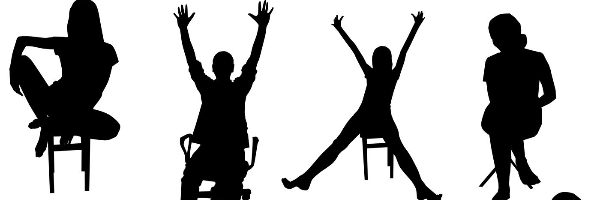What does leaning back in a chair mean in body language
Leaning back in a chair is a gesture that is associated with relaxation and comfort.
It’s seen as an indication of comfort and ease which can be helpful to use when you want to seem more relaxed in a conversation.
However, there are many other meanings when you see someone leaning back in a chair, and that all depends on context.
Leaning back in the chair table of contents
- What does leaning back in a chair mean in body language
- Understanding context in body language
- Learn to baseline
- Read in clusters
- Male body language leaning back in chair
- Body language woman leaning back in chair
- Body language meaning leaning back in chair
- Body language leaning back in chair hands behind head
- Summary
Understanding context in body language

The word context according to a quick search in google “the circumstances that form the setting for an event, statement, or idea, and in terms of which it can be fully understood”.
When reading somebody’s nonverbals we have to understand where we are, who we are talking with, and what the conversation is around in order to get a good understanding of context.
Understanding context will give us clues to how that person is really feeling.
For example, when you see someone being interviewed on TV for the first time, are they outside or in a studio? What are they talking about? Is it a topic they understand? How are they dressed? Do you think they are under stress or seem more relaxed?
When we study the context of the situation, this will give us clues or data points about how the person is feeling in the moment.
Male body language leaning back in chair

A male sitting in a chair with his hands on the armrests and his feet crossed on the floor leaning back in the chair, placing his weight on the back of the chair. This usually implies that he is feeling lazy or tired.
Some males will sit like this while listening to someone talk, while some may only do it while they are bored or feeling sleepy.
Overall, when you see a male leaning back in his chair, he is feeling relaxed, more at ease with what is going on around him.
Important to remember context is key here when reading a male’s body language when they are leaning back in a chair.
Body language woman leaning back in chair

Typically, when we see a woman lean back in her chair with her legs crossed she is displaying a sense of being relaxed and comfortable with what she is doing.
Remember context and understanding their baseline is key here when reading anyone’s nonverbal communication.
Body language meaning leaning back in chair
Leaning back in chair body language can also be mistaken as the person feeling relaxed and confident.
However, this body language can be a sign that the person is bored and not interested in the conversation. Therefore, we are trying to move away from the situation or conversation.
As we sit, our body weight shifts to one side, causing one shoulder to touch the back of the chair and one leg to stretch out behind us.
Pay attention when you see this, as this person could be becoming bored with the conversation.
When we feel relaxed, we will typically shift our weight so that both legs are on the ground and at a right angle to each other.
This position is referred to as a “relaxed posture” because it signifies that the person is comfortable with their surroundings, at ease with themselves, and not feeling any pressure from their surroundings or from what they are doing.
As above context is key to understanding what is really going on in a person’s head.
Body language leaning back in chair hands behind head

This is a neutral leaning-back pose that communicates that the person is feeling confident.
The leaning back in chair hands behind head pose looks comfortable and confident. This body language also suggests the person is in control of their area.
Leaning back in a chair with their hands behind their head sends a strong signal to anyone in the room that that person is in charge.
When we look at it from a nonverbal point of view, they are displaying their vital organs and have no fear anyone will harm them or attack them in close vicinity.
For example in a meeting, you may notice that an individual is leaning back in their chair with their arms behind their head. They are signaling that they are relaxed and confident.
In a meeting, an individual may be sitting upright with their arms held tightly to their chest. They are signaling that they are feeling defensive and have a sense of vulnerability.
When you see someone leaning back in their chair with their hands behind their head, they are displaying alpha male signals.
Learn to baseline
Once we understand someone’s context from a body language perspective, we need to find the baseline of that person.
The baseline is a person’s behavior when they are feeling relaxed or not in a stressful situation.
The term ‘baseline’ is a person’s behavior when they are feeling relaxed or not in a stressful situation. It can be used to compare to their behavior in a tense situation to see how they react.
For example, if someone’s baseline is that they push their glasses up on their nose often in conversation and we see them remove their glasses to get a point across, we know there is the meaning behind the nonverbal act of removing their glasses to emphasize a point.
A baseline in body language terms is a shift from comfortable to uncomfortable.
To learn more about baseline checking, please refer to our full article here.
Read in clusters
Understanding the baseline of a person is key to understanding what is going on.
Clusters are movements or shifts of body language that move away from a person’s baseline. These clusters are caused by anxiety, anger, frustration, or excitement.
By identifying clusters in a person’s body language, we can also identify their emotional state and feelings towards another individual or subject matter.
If you want to learn more about how to read the body language correctly, we suggest you do check out our full article here.
Summary
Leaning back in chair might mean that somebody has relaxed and is feeling comfortable.
Alternatively, leaning back might show that somebody is feeling defensive, especially when it’s in a professional setting.
Body language can easily be misunderstood and misinterpreted. It’s important to learn the meaning behind different gestures and leanings in order to avoid miscommunication in the workplace.
If you enjoyed reading this post, you may reading about Body Language Head.

